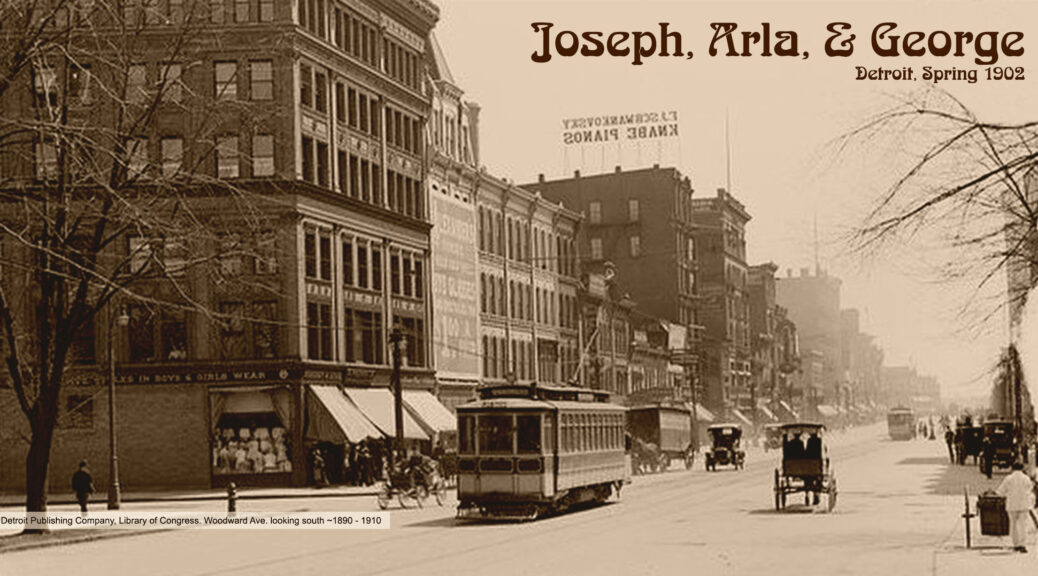
Detroit, Michigan in May 1902 had just celebrated its bicentennial, was America’s 13th largest city (& growing) and had a huge community of immigrants (12% of the population didn’t speak English, the highest percentage in the US). It would later become the Motor City, but even then, Detroit was the world’s largest manufacturer of heating and cooking stoves, built ships, produced cigars and tobacco, pharmaceuticals, beer, rail cars and heavy equipment. The city directory boasted of improvements in roads, water supply, street cars, public lighting and the number of books in its public library. Detroit was a city on the move.

Why is May 1902 in Detroit relevant? That’s roughly when George Sznarwakowski was conceived, probably in Detroit. He was born February 17, 1903. Papa – Robert Francis Sznarwakowski – barely knew his father. George died at 27 years old just before Papa’s fourth birthday.
I’ve written about Papa and his older brother as teenagers in Detroit during the depression in an earlier post and also about the surprise in Papa’s DNA test which showed that his Dad’s birthparents had been English. George Sznarwakowski’s adoptive parents were Polish, his wife and her parents were Polish, but Papa’s DNA told a story George probably knew nothing about.
Since my earlier blog post about the English DNA in Papa’s test, I’ve filled in details in the Ancestry tree for the Paull and Gardner families, hoping to use DNA matches with Papa to pinpoint which two people were George’s birthparents. A recent DNA match added the last puzzle piece, confirming my hypothesis about which two people – Joseph Paull and Arla Gardner.
There is so much I don’t know and probably can’t this long after George’s birth. None of the DNA matches have any details to add, unfortunately. I wish I knew how Joseph and Arla met and more about why they decided not to get married – both were single at the time George was born.

Joseph Paull was a 47-year-old salesman from Houghton, Michigan, the oldest son of the late“Captain” Joseph Paull, a Cornish immigrant. The title Captain was given to experienced shift bosses in mines – he didn’t go to sea! Arla Gardner, a 20-year-old stenographer working in Detroit, was daughter seven of eight for the late Charles Gardner, a carpenter whose family had been in the US since at least the early 1700s and Charlotte Curtis whose parents had left England for Michigan in the 1840s.
Arla’s father had died in 1896 and for a while, Arla and some of her sisters lived with her mother in Ann Arbor. Both of Joseph’s parents were dead and home was far away in the peninsula. As neither Arla nor Joseph had family in Detroit, perhaps one of the then-prevalent lying in hospitals assisted Arla and placed George for adoption? I see no suggestions Joseph or Arla knew John & Mary White (i.e. John Wojciechowski and Mary Sznarwakowski) who adopted George in April 1904, or John & Anna Sznarwakowski (Mary’s parents who raised George and adopted him after Mary died). It’s possible that Arla spent time with George at one of the hospitals serving unmarried women before saying goodbye, but she was working as a stenographer again in the 1904 Polk Directory (at the National Railway News Co. Same home address, but a different employer from the 1903 directory).
Joseph Paull married in June 1904 and settled down as clerk and then manager of a general store in Houghton, Michigan. Arla Gardner married a Detroit printer in October 1908. Joseph had four more children and Arla had three, before being widowed in 1925. Joseph Paull died in 1921. I would imagine they never saw one another – or George – again.
This family tree shows where the final DNA matches fit in – there are many more matches to others in the Paull, Richards, Gardner, or Curtis families not shown., Unlike the more distant matches (3rd, 4th or 5th cousins), these two matches are close (the amount of centimorgans in the match) and in living people tied to the subsequent marriages of Joseph and Arla – the only explanation is for Joseph and Arla to be George’s birthparents.. I’ve omitted the first names of the DNA matches for privacy.

George’s story, and his too-short life, stands by itself, but I find the additional details of the families from which he – and all his descendants – originated fascinating and enriching. I’d love to have shared the full story with Papa (he knew the first part detailed in the original blog about Cornish ancestry).

